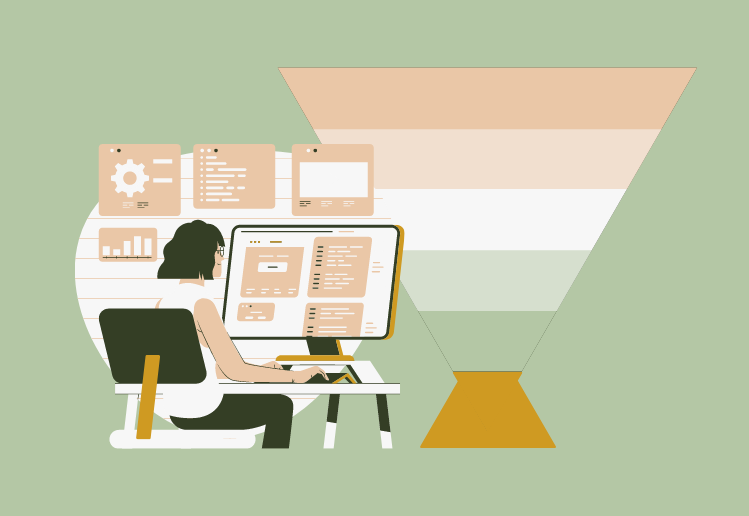If you want your content marketing to succeed, you need to strategise rather than produce content on the hoof. One of the easiest ways of doing this is to create a content marketing strategy with funnels. Content marketing funnels, sometimes called sales funnels or purchasing funnels are a key tool in a marketer’s skill set. Here is my guide to building a content marketing strategy using funnels.
What Is a Content Marketing Funnel?
A content marketing funnel is a system that describes your customers’ journey and the types of content they will want to engage with at each stage. It starts with a potential customer not knowing your company exists to becoming a dedicated customer. Possibly even a brand ambassador. A funnel is used as a visual cue. There is a larger number of people at the top, or the widest part of the funnel, to show your potential customers, your leads. The funnel then filters down to the narrowest point which includes your actual customers and brand ambassadors.
By understanding these different audiences and the stages in the buying process they are at, you can produce the right kind of content. Every company’s marketing funnel is slightly different in the types of content it will need but the different stages generally stay the same. The key takeaway should be focusing on producing quality content for your audience over the sales gains you can make.
Different marketing funnels
There are several funnel concepts that are utilised by the marketing community. Most have three different sections but some have five stages. Below are some examples of sales and marketing funnels to get you in the mindset of how funnels work. The different formats will help you pick one that fits your business best.
TOFU, MOFU, BOFU Sales Funnel
One of the most used marketing funnels is TOFU, MOFU, BOFU. These different names stand for; top of the funnel, middle of the funnel and bottom of the funnel. These are the different stages in this sales funnel.
- Customer with a need, want or recognising a problem. (TOFU)
- Informational search to find a solution to their problem (TOFU)
- Evaluation of different options (MOFU)
- Making a purchase decision (BOFU)
- Post-sale behaviour (BOFU)
AIDA Funnel
The AIDA funnel is a useful acronym to help you create content for the different stages in a funnel. They include:
- Attention – Beginning the search for a solution to an issue
- Interest – Starting to find more detailed information on solutions
- Desire – Comparing and contrasting different options, edging towards a favourite
- Action – Making the purchasing or first contact for a service.
Purchasing Funnel – Discovery, Consideration and Purchase
A purchasing funnel focuses primarily on the end goal of a purchase and can be helpful for eCommerce sites where there is a direct and easy way to purchase the product.
- Discovery – Realising you need or want a particular product and beginning the search.
- Consideration – Looking for various options, comparing pricing, features and companies.
- Purchase – Deciding on the right option for you and purchasing the item.
Marketing Funnel – Attract, Engage, Delight
This is probably my favourite way of looking at a sales funnel as it doesn’t just reach potential customers, it shows you how to hone your content to create brand ambassadors. This way of looking at content puts it in the perspective of the marketer. These emotive words show what marketers should be doing to create better content for their audience.
- Attract – Creating worthwhile content that introduces new leads to your brand when they are looking for solutions.
- Engage – Produce entertaining, informative and inspirational content that builds trust with your company and shows your audience your expertise.
- Delight – Offer exciting and valuable content that proves you’re the business they should buy from. Continue offering amazing content post-sale to create brand ambassadors out of your existing customers.

Choosing content to create with funnels
Hopefully, you now understand how marketing or sales funnels work. Now you recognise the different stages your audience might be at, it’s time to create content that satisfies their needs. This is my example of a marketing funnel that covers all the steps above and combines into a powerful content marketing funnel.
1. Awareness
At the awareness stage, the user does not know your business at all or may only be vaguely aware of it. At this point, they may not know they need your services or don’t realise you provide the items or services they want. Content for this stage could include;
- Company blogs and guest blogging
- SEO for products and services
- Social media posts
- Podcasts
- Online ads including PPC and social media
Think about what questions your potential customers are asking and what keyword they may search for on search engines. Read how to do keyword research here.
2. Interest
The user has seen your brand a number of times, they may have followed your social media profiles and visited your website. They may be starting to find information to see if you do the things they need. Content for this includes:
- Web page/product page copy
- Videos
- Case studies
3. Evaluation
After gathering more information, the user should be in a position to start comparing you to other similar businesses. This evaluation period is where your offering needs to stand out and any questions asked are answered in the right way. Content for this phase includes:
- Pricing Guides
- Newsletters
- Whitepapers
- Webinars
- Slideshows
- Remarketing campaigns
4. Commitment
Once they are at the point where your company stands out from other companies, they are in the commitment stage. They are ready to learn a little bit more and may have some loyalty to your brand. They are ready to dip their toe further into your business. Content for this stage includes:
- Trials
- Demonstrations
- Personalised digital or physical packs
- Explainer videos and how-to articles
- FAQs
5. Sale
You finally made it! You have a new customer. However, that doesn’t mean you are at the end of your content strategy. Remember from the beginning of this guide, content is about value not sales. So just because you’ve made that sale doesn’t mean you always will. With the exception of a few products, you should be able to resell to customers in the future. As for services, most will be something ongoing that you’d like to keep providing. Therefore, the after-sales content plan is as essential as all the other stages. Examples of content for this after-sales phase includes:
- Welcome emails including how to get support and provide reviews
- News updates about products and services
- Newsletters that include discounts and offers
6. Loyalty
Provide content post-sale to encourage free advertising through brand ambassadors. If you can show your customers some love you will reap the rewards long after their purchase.
- Inspirational blogs, videos and images
- Gifts and personalised content
- Referral campaigns and early bird offers
- Feedback forms and questionnaires.
These are more interactive than at the beginning of the marketing funnel but they serve businesses well. They create happy customers who can be turned in to repeat customers and brand ambassadors.
Build your content marketing strategy with funnels
If you’d like help developing a bespoke content marketing strategy, get in touch. I can create a personalised content marketing package. Gain all the content you need for the different stages in your buying process. Whether its one-off content such as whitepapers, or monthly content marketing to boost your organic reach, I can help. Contact me today and let’s grow your business together.

